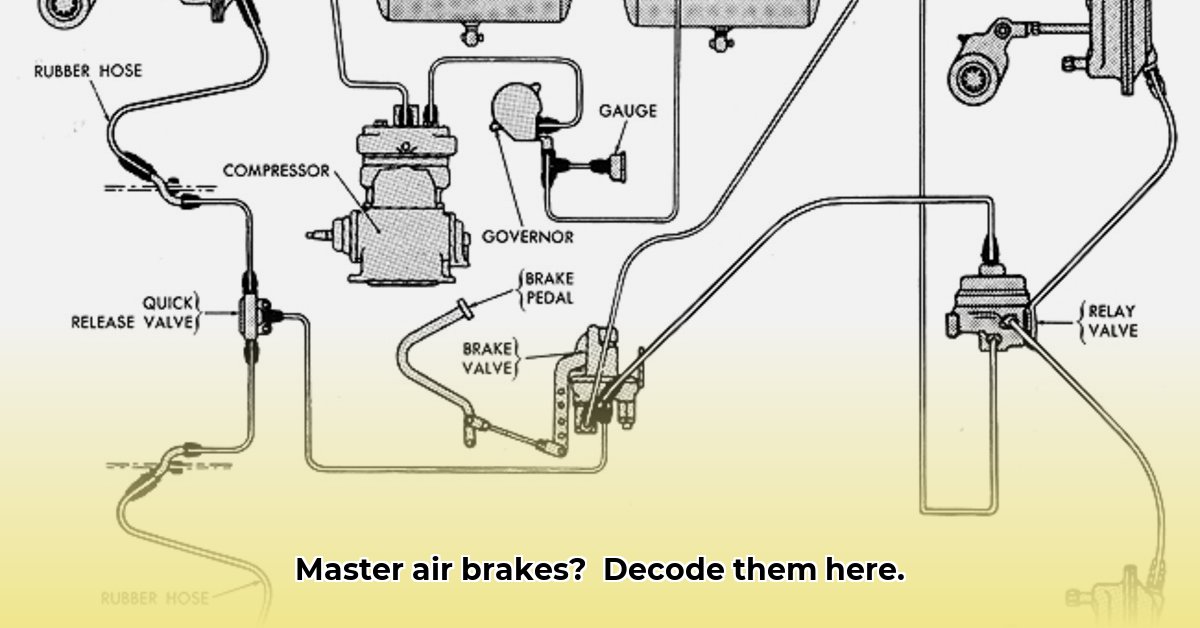
Air Brake System Overview: Understanding the Fundamentals
Understanding your tractor-trailer's air brake system is paramount for safe operation. This guide provides a comprehensive overview, using diagrams (not included here, but readily available in your vehicle's manual) to illustrate each component's function and location. Think of this system as a network designed to convert air pressure into braking force. Did you know that a properly functioning air brake system can significantly reduce your stopping distance, especially at higher weights and speeds?
The Air Compressor: The Heart of the System
The air compressor (a powerful pump) generates and maintains the compressed air needed for braking. It continuously fills air storage tanks. A malfunctioning compressor will render your brakes inoperable—a critical safety concern. Therefore, regular maintenance and inspection (check your owner's manual for recommended schedules) are essential.
Air Storage Tanks: Reservoirs of Braking Power
Compressed air from the compressor is stored in large tanks (typically two or more for redundancy). These act as reservoirs, providing a crucial backup in case of compressor failure or leaks. Insufficient air pressure, indicated by warning lights, signals an urgent need for attention. How many air tanks are typically found in a modern tractor-trailer? Most have at least two, for added safety.
Control Valves: Precision Air Management
Control valves regulate the flow of compressed air throughout the braking system. They precisely direct airflow to the brake chambers, controlling the braking force applied to each wheel. These valves are crucial for consistent and balanced braking; failures can result in unsafe braking performance. Regular testing is recommended to detect any problems early.
Brake Chambers: Transforming Air Pressure into Braking Force
Brake chambers translate air pressure into the mechanical force required to stop your wheels. Located near each wheel, they contain diaphragms that expand when pressurized, activating either brake shoes (on drum brakes) or calipers (on disc brakes). Examine your diagrams to visualize how the air pressure actuates these mechanisms. Frequent visual checks for wear and tear are advisable.
Air Lines and Fittings: The System's Arteries
Air lines and fittings form a network transporting compressed air throughout the system. Leaks in this network are frequently the cause of braking system failures. Regular inspections are crucial for early detection. What's the most common cause of air brake failures? Leaks in air lines and fittings often top that list.
Decomposing Your Air Brake Diagram: A Practical Approach
Locate Your Diagram: Obtain a diagram specific to your tractor-trailer model. Using a generic diagram might be misleading.
Identify Key Components: Identify the compressor, tanks, valves, brake chambers, and their interconnections.
Trace Airflow: Follow the compressed air's path from the compressor to the brake chambers. Understanding this flow is crucial for diagnosing problems.
Recognize Safety Features: Locate safety valves (e.g., emergency brake valves) and other critical components.
Implement Regular Inspections: Use the diagram to guide regular visual inspections and maintenance. Early detection of potential problems is vital.
Diagnosing Air Brake Issues: A Step-by-Step Guide
Air brake problems, especially intermittent ones, are serious safety hazards. Here's a methodical approach to diagnosis:
Visual Inspection: Thoroughly inspect all lines, fittings, and components for leaks, cracks, or damage.
Pressure Check: Verify air pressure in the storage tanks with the engine running. Low pressure suggests a leak.
Leak Test: With the engine off, monitor pressure drop to pinpoint leaks. You can often isolate the leak using soapy water.
Relay Valve Test: Test relay valves to ensure proper air flow regulation.
Brake Chamber Inspection: Inspect brake chambers for leaks, damage, or sticking.
Low Pressure Switch Test: If necessary, test the low pressure switch.
Prioritizing Safety: When Professional Help Is Crucial
While understanding your air brake system is empowering, professional maintenance is non-negotiable. For significant problems, or for any doubts, consult a qualified mechanic immediately. "Regular professional maintenance is paramount," says John Miller, Certified Master Mechanic at Highway Transport Solutions. "Ignoring potential issues can have catastrophic consequences." Your safety and the safety of others on the road depend on it.
Core Takeaways:
- Regular inspection and maintenance are crucial for preventing major air brake failures.
- Intermittent air brake problems necessitate prompt diagnosis and repair.
- A comprehensive understanding of air brake system components is essential for safe operation.
This guide enhances your knowledge, but professional maintenance and training remain indispensable. Remember, safety always comes first.